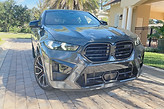
Delivering Everything.
Let’s assume a car enthusiast wishes for a BMW performance driving machine. A lovely coupe like the M4 might be just the ticket, but he needs four-doors and the usefulness of a sports utility. Our X6 M Competition asserts to deliver all the attributes an aficionado could ask for; a coupe-like SUV with blistering performance. Depending on your point of view, it’s either the world’s best or silliest Bavarian offering. Best, because it’s a machine that can accomplish a myriad of tasks. Imprudent, since hot rodding a 5,454-pound family hauler seems to ignore the laws of physics.
After a week’s work of zipping around the countryside, this big BMW won me over with its giant personality at the curb and performance on the pavement. BMW’s model name strategy uses odd numbers for upright sedans and SUVs and even to identify coupe styling. So our X6 M is the coupe-like interpretation of the popular X5 M sports utility. The swept-back styling gives this big fella a tall, station wagon appearance while the black nostrils along with other air intakes define determination. In back, a subtle lip spoiler over quad exhausts and lower air management provide punctuation.
Inside, our Davit Grey X6 M, occupants are welcomed with a dramatic reddish orange and black full leather interior along with carbon fiber accents. I expected the big, leather-wrapped steering wheel to sport a flat bottom and a red leather stripe at 12-oclock like some other M models, but I easily settled for the red M(1) and M(2) buttons that were properly perched above the multi-function controls. Seats are nicely bolstered without sacrificing comfort on longer journeys.
BMW’s X6 M is identified as a “mild hybrid” with its 48-volt electrical system powering a compact electric motor that’s integrated into the 8-speed M Steptronic transmission. The motor adds a modest 12 HP to the propulsion along with 147 lb-ft of torque, hardly enough to propel this big guy, but the torque is instant and appreciated. Of course it’s accompanied by the 4.4-liter, 617 HP M-tuned V8 so a launch to 60 MPH is achieved in 3.7-seconds, aided by electricity along with higher ratios in the lower gears. And at cruising speeds, passing is, in a word, effortless. Top speed for our M Driver’s Package optioned X6 M is 177 mph, but I resisted verifying that specification on public roads.
Prodigious power is an expected attribute in a BMW M machine, but so is luxury, especially when the window sticker shoots into six-figures. Our test vehicle’s robust equipment list included an Executive Package that offered not only front and rear heated seating, but massaging available for the driver and front passenger. And if you brought a soft drink or coffee inside, the cupholders could be set for heating or cooling. That’s first-class treatment.
Of course there are rivals, even in this uber-power SUV coupe segment. Audi’s SQ7 brings 500-horses to the race and a wee-bit more modest MSRP. Mercedes-Benz counters in both price and performance with its AMG GLE 63 S while Porsche ups the game in price, dispatch and fuel economy with its Cayenne Turbo E-Hybrid Coupe. And if you have another $200-grand to spend, Lamborghini’s Urus SE Hybrid or Aston Martin’s DBX are lovely choices to pursue.


THE FINE PRINT
2026 BMW X6 M Competition
TYPE: Front-engine, all-wheel-drive
ENGINE: 4.4-liter Twin Turbo V8
HORSEPOWER: 617 @ 6,000 RPM
TORQUE: 553 lb.ft. @ 1,800 RPM
BASE PRICE: $128,700
AS TESTED: $147,025
FUEL CONSUMPTION: 13-city, 25-highway, 20-combined




